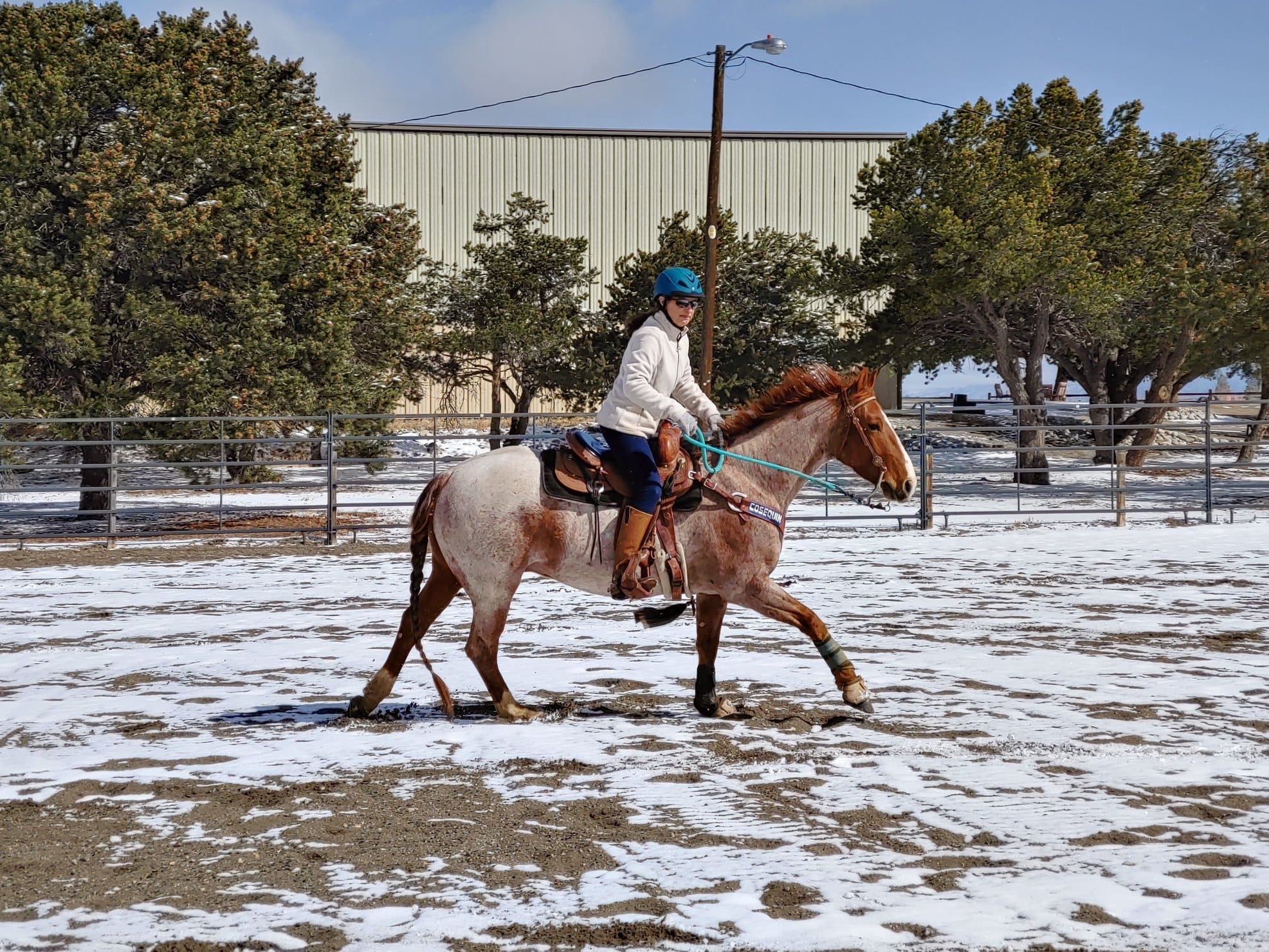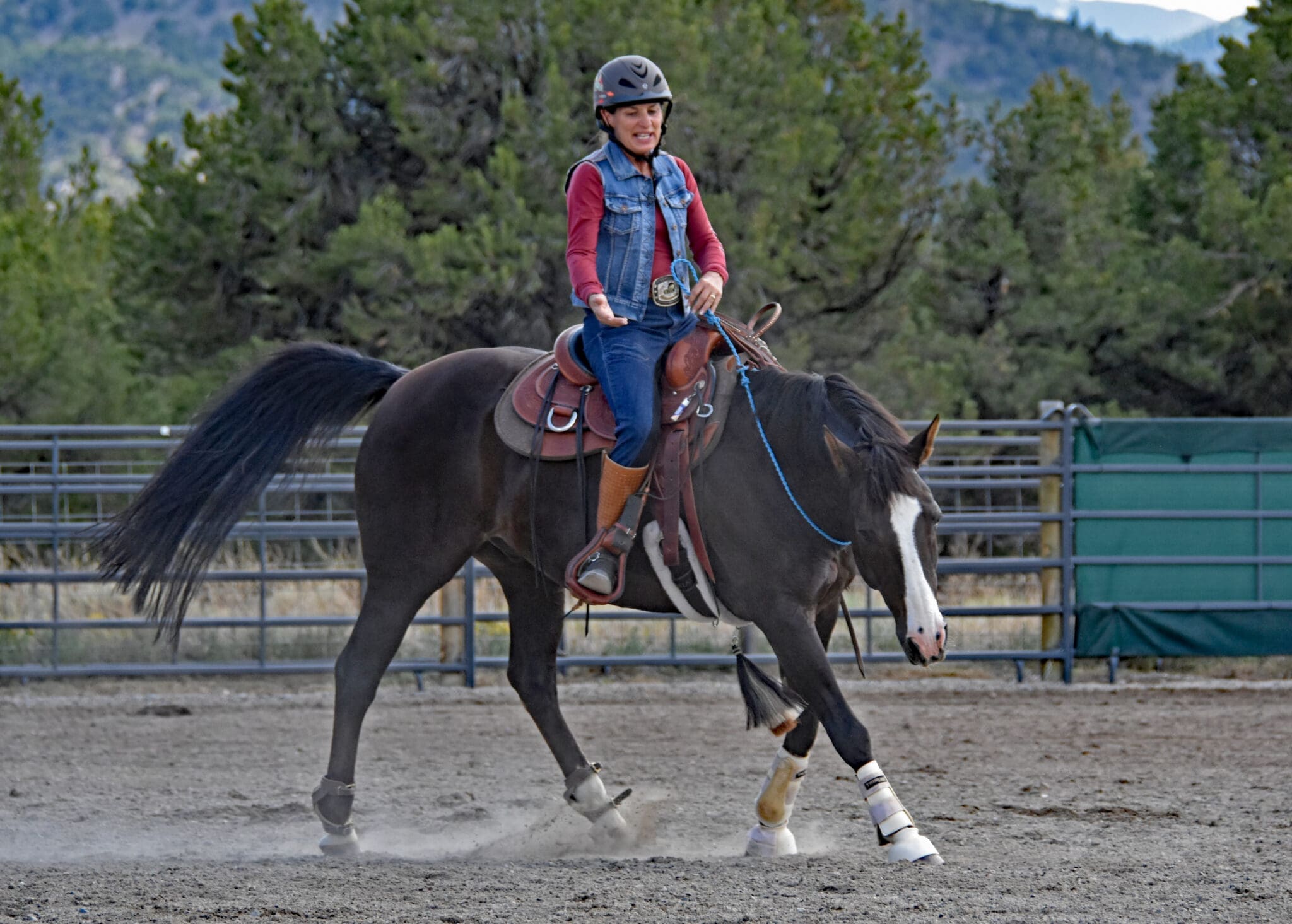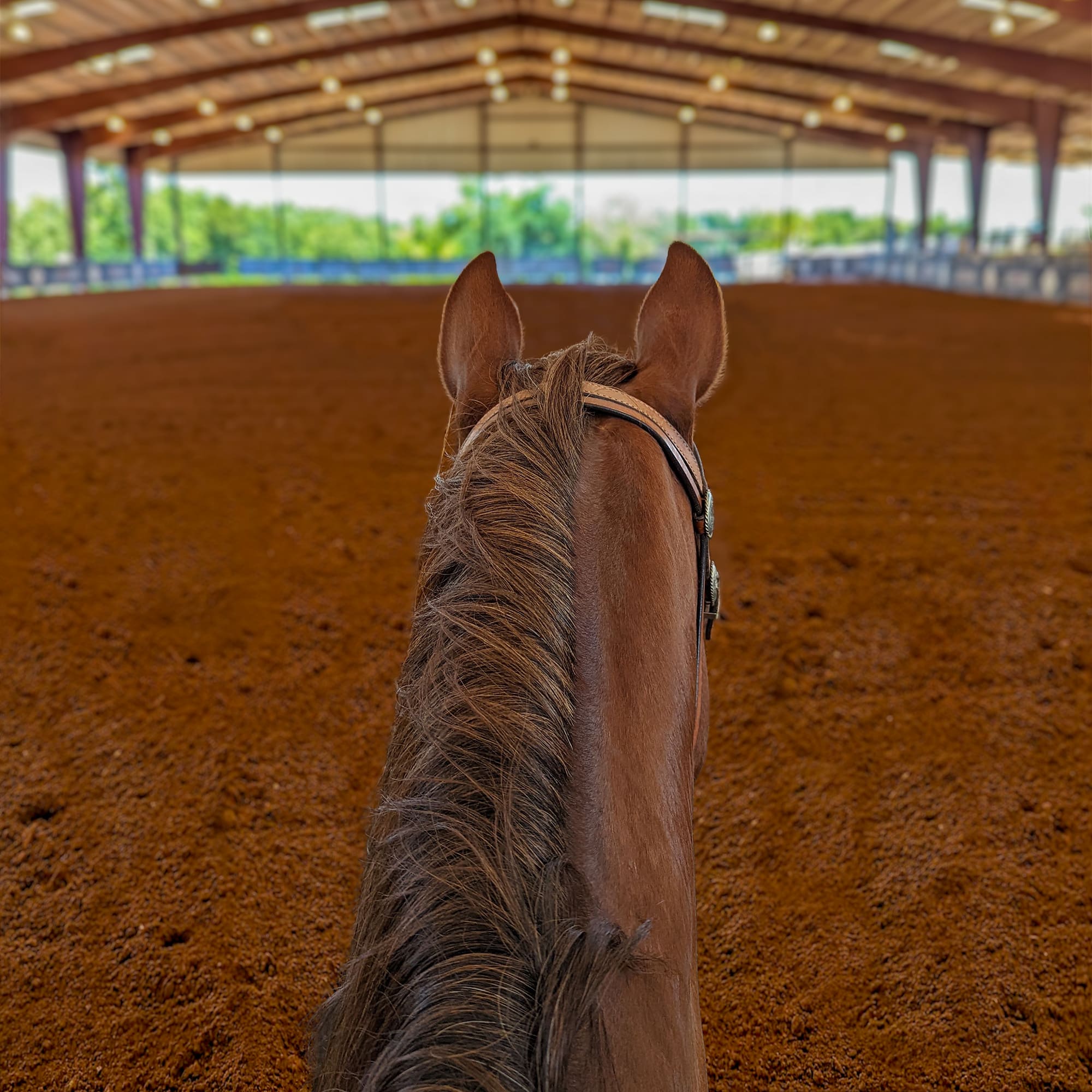
We are three months into Horse Goals or Bust!—my nine-month plan to help you accomplish your horsemanship goals and live your dreams. Many of you have jumped onboard for this ride, including most of my online coaching students. It’s been so much fun for me to hear about your goals—thank you for sharing!
In the last two months, we’ve brainstormed on our horsemanship aspirations, we’ve refined and written measurable goals, and now we are charting a course that will get us there over the next six months. I’ve given you resources and assigned you homework, making it easy to start the process.
If you don’t do anything else, you should complete the goal worksheet—it might be very illuminating! In fact, several people told me they used a second one to set goals in other areas of their lives, which prompted me to take action. I printed two more copies of the worksheet and devoted time formulating and refining goals in my professional life and for recreational pursuits!
Your goals provide the framework on which to build your action plan—that’s why we broke it down and got specific. Now it’s time to act! This month, we start on the first and longest leg of our journey—horse and rider fitness! And yes, there will be homework.
I’ve put together information on fitness and a simple test you can take to discover your personal baseline fitness level, and where you need to direct your exercise, as it relates to equestrian sports. I’ll guide you through the test and give you a form to chart your progress over the coming months. Then I’ll help you build your own personal conditioning plan, with an emphasis on it being FUN, PRACTICAL, and HORSEY.
Be sure to listen to the upcoming episode of my podcast, Ride On with Julie Goodnight, as I address the horse’s current fitness level and develop a conditioning plan to help your horse build strength, increase fitness, and look amazing! But here, the focus is on you—to help you feel stronger, better balanced on the horse, and more confident as you ride!
Rider Fitness Assessment
Improving fitness takes time and requires a methodical and practical approach. It can take months to get a good result. That’s why it’s one of the first issues to address, for both horse and rider, when embarking on an ambitious campaign. Fitness requires your patience and commitment, but you’ll begin to see benefits almost immediately.
It doesn’t matter how fit you are now—that’s only the starting point. What matters is where you are headed. Remember? Horse Goals or Bust! Although horseback riding can accommodate almost everyone, no matter their fitness or physical ability, without question, getting in better shape will improve your riding.
I’ve put together an equestrian fitness test, to help you develop a personalized conditioning plan. It’s loosely based on common at-home fitness tests, but also includes a mounted component, with an emphasis on the aspects of fitness that relate most to riding horses. I found some awesome online resources from the Mayo Clinic, and have shared some of them in the worksheet.
For this assessment, we’ll be looking at six areas of equestrian fitness: Aerobic capacity; strength and core stability; flexibility; body composition; mounted balance and endurance; with consideration to your personal health and well-being too.
The Equestrian Fitness Assessment is a handout you can use as a guide, complete with instructions on doing the tests and how to interpret your results. The Equestrian Fitness Score Sheet will help you tally your scores and chart your personal progress over time. Remember, this is all about you—and for your eyes only. It’s not about comparing yourself to others or shaming yourself. It’s about taking that small next step to achieve your goals and aspirations. You are worth it!
Taking the Test
Don’t panic! There are no wrong answers, you cannot fail it, and no one needs to see your results but you. After you’ve studied the handout and gathered the few tools you’ll need, it won’t take long to complete most of the exercises and measurements. If you complete the at-home portion and the riding portion in one day, it will count as a decent workout, and you’ll have already started on your plan!
If your current fitness level is low, don’t worry! Just do as much as you can and there are always ways to modify exercises to make them easier. Be smart and never push yourself beyond your own physical limitations and consult your physician before starting any new exercise regimen, especially if you are being treated for medical conditions or if you have not been physically active recently.
I highly recommend enlisting the help of a friend or workout buddy for this fitness test (they don’t have to be a rider). Some of the measurements are tricky to do yourself and the moral support always makes it easier.
I’ve targeted this test toward the average recreational rider, who happens to be female, over 50, and riding less than five years. When it’s time to interpret your results, cut yourself some slack if you are older or overcoming obstacles, and challenge yourself if you are younger or already in great shape.
It’s not about comparing yourself to others, but about knowing where you are currently in your overall fitness and improving your scores over time. It doesn’t pay to inflate your scores on the test. That will make it harder to see your improvement over time, on paper.
The at-home portion of the test will only take you about 30 minutes. Before taking the fitness assessment, gather the tools you’ll need: a cloth measuring tape, a piece of HD tape, a timer/stopwatch (or your phone). If you have a fitness tracker, measuring your heart rate (HR) will be easy, otherwise you will need to know how to take your pulse. You’ll also need a box or step and know your current weight.
For the mounted exercises, you’ll need your normal riding gear, a tacked-up horse, and a place to ride. Once you are mounted on your horse and warmed-up, the riding portion of the fitness test should only take 15-20 minutes. If you ride a gaited horse, you may want to borrow a trotting horse for the test or alter the test by going at your fastest gait, while riding serpentines and figure-8s. If you don’t have a horse, spring for a lesson on a school horse and enlist the help of a riding instructor. Alter the test, as needed, to meet your ability level that of your horse.
Once you’ve completed the test and have your baseline scores, you’ll know how to focus your conditioning plan and have a better idea of what kinds of exercises are more useful and more palatable.

Developing Your Fitness Plan
The most important aspect of any conditioning plan is that it gets used! I was in my forties when I first started working out daily. Before that, my job as a horse trainer involved so much back-breaking labor, that the thought of working out was laughable. I started on a small scale, doing the activities I enjoyed, and it grew over time.
When developing your fitness plan, look for exercises that you enjoy, in places you want to be, and with people you enjoy. I love hiking, biking, paddling, and skiing, so I orient my other workouts around these activities. Maybe you like to multi-task? Yard work, dog walking, and shoveling snow can count as workouts. Be creative.
Misery loves company and whenever possible, having a workout buddy will make workouts more tolerable. I even have a friend on the other side of the country I work out with. We schedule “walk and talks,” where we both are walking and talking on the phone. I have another friend who I do video workouts with on Zoom. Having a friend to exercise with, in person or virtually, makes you both more accountable and exercise becomes something to look forward to.
If you have a personal trainer or already go to a gym, use that resource to your advantage! A professionally designed conditioning plan would be awesome, but your workouts should not be complicated, and they should definitely be fun! I also love to dance, so my indoor workouts tend to be dance-style aerobics or Pilates.
Be sure to add variety to your conditioning plan and keep in mind that balance and core strength are the most important aspects of fitness for equestrians. We know that cross-training has many advantages, not the least of which are working different muscle groups and preventing boredom. I know for certain that the other sports and activities I’ve participated in all my life (ballet, mountain biking, paddling, skiing) have helped me stay as fit as a professional rider should be and have also honed my riding skills.
From the results of your fitness test, you should have a better idea which categories of fitness you need to focus on—aerobic capacity, core strength, endurance, flexibility, or body composition. Or perhaps the results of your fitness test indicated you need to focus more on your health and mental well-being. If so, that will drive the design of your fitness plan, more than going to the gym or doing calisthenics.
NOTE: Your mental well-being and health are a huge part of your overall fitness. Do not overlook this area and for some, this may be the largest part of your plan. If your confidence needs a boost, if you need an attitude adjustment, if you have underlying health concerns you are ignoring, getting in better shape is not the most important thing. Focus on your health and well-being first and foremost, and your workout regimen secondly.
Before making your new fitness plan, make a list of all the types of exercise you enjoy, have access to, or that you can do with your buddies. It’s great to have more than one exercise option for each time slot—maybe your aerobic exercise includes a class at the gym, a vigorous walk, cycling, an at-home video, or trotting without stirrups for ten minutes. Having variety and being able to substitute activities, makes your plan more flexible and fun.
With your list in hand, next you need to schedule your exercise routine within these simple parameters:
- 150 minutes of moderate aerobic exercise per week (brisk walk, water aerobics, bike level terrain), or more intense aerobic exercise like running, swimming, biking hills.
- Strength training for all major muscle groups (upper body, lower body, core) 2X a week (weights, calisthenics, hip-hop abs, or some heavy barn work!)
Plan a weekly workout schedule that is within reason for you, that is easily achievable, and one that you will commit to. Start small and build. Block out the time on your calendar and make it a priority every day (for me, that means doing it first thing in the morning) Do your best to find some company—even if it means sharing your workouts virtually.

Ready to Ship Today! (719) 530-0531
Make Exercise Fun!
The more you enjoy your workouts, the more likely you are to have success with your fitness plan. Ultimately, as you get fitter and lose weight, that becomes that greatest reward and it will become the force that drives you. But in the beginning, the more fun you have the more committed you will be.
Beyond sharing exercise time with friends, doing workouts that are fun, and keeping variety in your plan, here are a few more ideas to add spice to your fitness plan…
- Pilates: Whether you take an in-person class or follow an online video, this exercise routine was developed for professional ballet dancers and is focused on core strength and flexibility. Its relevance to riding is remarkable and you will feel improvement by the second time you do it.
- Ride Bareback: Obviously this will help your balance and core strength and it’s fun! Build up to trot and canter if you can. You’ll develop strength and endurance and the good news is that your horse is getting a workout too!
- Ride Without Stirrups: For the same reasons as riding bareback. This will also help your leg position, posting, and sitting trot skills as you build strength and burn calories.
- Rigorous Grooming: A full head-to-tail, multi-brush grooming job on a muddy horse, using two hands (wax on-wax off), will burn calories and give you a full body workout (not to mention make your horse shine!).
- BOSU: An exercise tool that has a heavy platform on one side and half a large exercise ball on the other side (it stands for Both Sides Utilized). You can follow the video workouts and use the BOSU to improve your dynamic balance and core strength. Like Pilates, it is very relevant to riding and you will notice improvement right away and the unique challenges of this workout makes it fun.
Make a Commitment to Your Horse and Yourself
The goals you have formulated are important to you and you are committed to action. Improving your personal fitness gradually and sustainably will greatly increase your chances of success AND increase your self-confidence, while improving your health. What’s not to like about that?
I know that you are committed to having a better relationship with your horse and becoming a better rider. Your horse does its part, now you must do yours. Make a promise to your horse, today, that you are committed to improving your personal health and fitness too. You ask for a lot from your horse, now you must ask the same of yourself.
Don’t miss my podcast this month, where we’ll review the fitness test results for a few Horse Goals or Bust! players, including myself, and we’ll share our custom fitness plans. Then, we’ll dig deep into analyzing your horse’s fitness level and devise a conditioning plan that will help prevent injury and make your horse strong.
As we progress through our Horse Goals or Bust! series, next month we get into the weeds on skill assessment and training plans for both you and your horse. Then we focus on horse grooming, resource acquisition, and logistics for accomplishing your audacious horsemanship goal for 2023!
Remember, if you haven’t started yet, it’s not too late! Go back and review my previous blog posts and podcast episodes and you’ll have the resources you need to discover your horsemanship dreams, write specific outcome goals, and develop your action plan.
When it comes to horse training, we know that slower is faster, but did you know that it’s true for humans as well? Accomplishing meaningful goals takes time, planning, and commitment—especially when horses are involved. We are working now to achieve the goals we set 6-8 months from now, and I hope you will join us!




